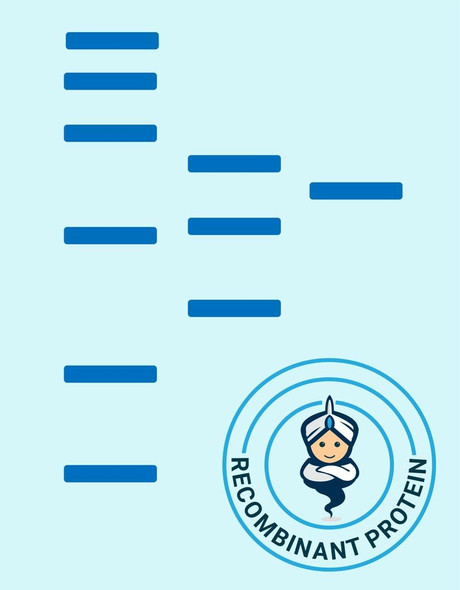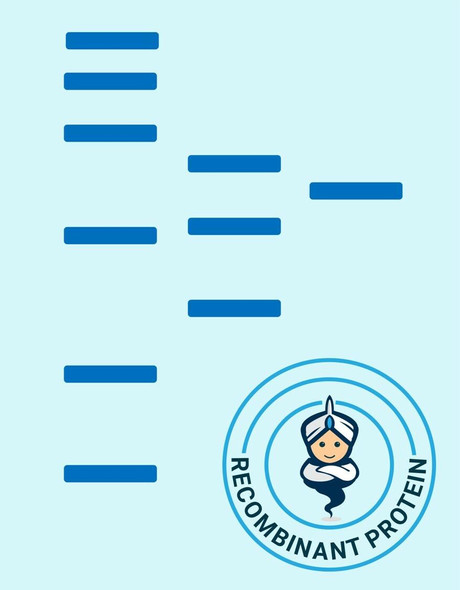Human PAIP2 Recombinant Protein (RPPB4183)
- SKU:
- RPPB4183
- Product Type:
- Recombinant Protein
- Species:
- Human
- Uniprot:
- Q9BPZ3
Description
| Product Name: | Human PAIP2 Recombinant Protein |
| Product Code: | RPPB4183 |
| Size: | 25µg |
| Species: | Human |
| Target: | PAIP2 |
| Synonyms: | Poly(A) Binding Protein Interacting Protein 2, PABP- interacting protein 2, HSPC218, PAIP-2, PAIP2A, Polyadenylate-binding protein-interacting protein 2, PAIP2, MGC72018. |
| Source: | Escherichia Coli |
| Physical Appearance: | Sterile filtered colorless solution. |
| Formulation: | The PAIP2 protein solution contains 20mM Tris-HCl, pH-8, 1mM DTT & 10% Glycerol. |
| Stability: | Store at 4°C if entire vial will be used within 2-4 weeks. Store, frozen at -20°C for longer periods of time. For long term storage it is recommended to add a carrier protein (0.1% HSA or BSA). Avoid multiple freeze-thaw cycles. |
| Purity: | Greater than 90.0% as determined by SDS-PAGE. |
| Amino Acid Sequence: | MGSSHHHHHH SSGLVPRGSH MKDPSRSSTS PSIINEDVII NGHSHEDDNP FAEYMWMENE EEFNRQIEEE LWEEEFIERC FQEMLEEEEE HEWFIPARDL PQTMDQIQDQ FNDLVISDGS SLEDLVVKSN LNPNAKEFVP GVKYGNI |
PAIP2 has a role as a repressor in the regulation of translation initiation of poly(A)-containing mRNAs. PAIP2 inhibitory activity on translation is mediated through its action on PABPC1. PAIP2 displaces the interaction of PABPC1 with poly(A) RNA and competes with PAIP1 for binding to PABPC1. PAIP2 association with PABPC1 results in disruption of the cytoplasmic poly(A) RNP structure organization.
Recombinant Human PAIP2 produced in E.Coli is a single,non-glycosylated polypeptide chain containing 147 amino acids (1-127 a.a.) and having a molecular mass of 17.1 kDa.PAIP2 human recombinant is fused to 20 amino acid His Tag at N-terminus and purified by convential chromatogrpahy techniques.
| UniProt Protein Function: | PAIP2: Acts as a repressor in the regulation of translation initiation of poly(A)-containing mRNAs. Its inhibitory activity on translation is mediated via its action on PABPC1. Displaces the interaction of PABPC1 with poly(A) RNA and competes with PAIP1 for binding to PABPC1. Its association with PABPC1 results in disruption of the cytoplasmic poly(A) RNP structure organization. Interacts with the second and third RRM domains and C- terminus regions of PABPC1 in a 2:1 stoichiometry. Belongs to the PAIP2 family. |
| UniProt Protein Details: | Protein type:RNA-binding Chromosomal Location of Human Ortholog: 5q31.2 Cellular Component: cytoplasm Molecular Function:protein binding; translation repressor activity Biological Process: negative regulation of translational initiation |
| UniProt Code: | Q9BPZ3 |
| NCBI GenInfo Identifier: | 46397013 |
| NCBI Gene ID: | 51247 |
| NCBI Accession: | Q9BPZ3.1 |
| UniProt Secondary Accession: | Q9BPZ3,Q49A06, Q9H0Y5, Q9P0Q8, B2RBI1, D3DQC6, |
| UniProt Related Accession: | Q9BPZ3 |
| Molecular Weight: | 14,984 Da |
| NCBI Full Name: | Polyadenylate-binding protein-interacting protein 2 |
| NCBI Synonym Full Names: | poly(A) binding protein interacting protein 2 |
| NCBI Official Symbol: | PAIP2�� |
| NCBI Official Synonym Symbols: | PAIP-2; PAIP2A�� |
| NCBI Protein Information: | polyadenylate-binding protein-interacting protein 2 |
| UniProt Protein Name: | Polyadenylate-binding protein-interacting protein 2 |
| Protein Family: | Polyadenylate-binding protein-interacting protein |
| UniProt Gene Name: | PAIP2�� |
| UniProt Entry Name: | PAIP2_HUMAN |










